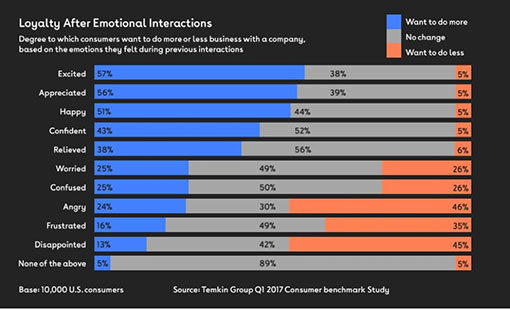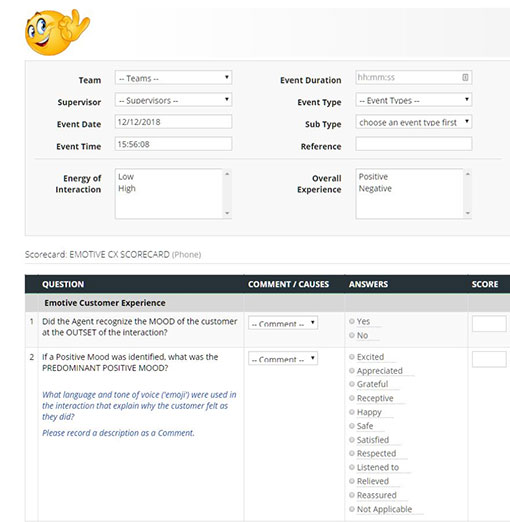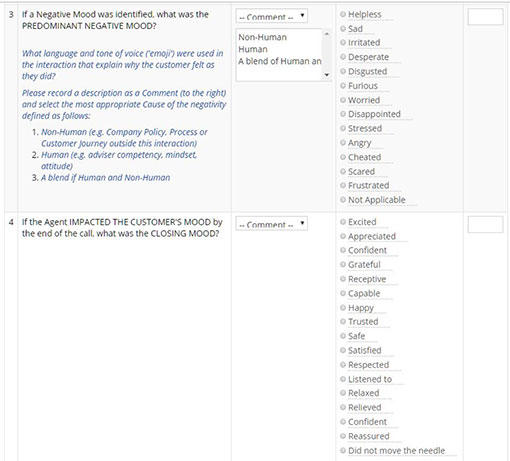Dick Bourke discusses how the emotive customer experience (CX) can be calculated from the contact centre.
Emotive CX is a suggested framework based on the omnichannel capabilities many organisations are currently building. It can be used to measure and quantify how emotions play into the customer experience. Here’s a tip: emotions are fundamentally critical to facilitating a successful customer experience and journey.
The big idea is that the agent needs to be trained to feel what the customer is feeling, and to amplify it when it is positive and transform it when it is negative, and finally deliver an emotionally authentic and functionally effective outcome.
In fact, Forrester recently reported that in 17 out of 18 industries, customers are influenced more by how they feel than by a product’s actual effectiveness. That’s a lot of industries and a lot of customers, which is why Emotive CX can be so valuable to call centre managers’ approaches to their customer experience strategy and how they score and manage their agents. This approach is understandably gaining attention from enterprise executives and call centre managers alike.
While it may not be easy to measure or quantify a highly subjective concept like emotions, it is certainly not impossible.
Martin Hill-Wilson is the global authority on social customer service, and a frequent keynote speaker on the topic of Emotive CX. He is the co-author of the highly successful publication, Delivering Effective Social Customer Service.
In his recent thought leadership series sponsored by New Voice Media, Hill-Wilson defines Emotive CX for customer interactions as the ability to optimise the way a customer feels during and after a contact centre interaction.
Working with this definition, we can begin to explore the ways in which to measure Emotive CX.
Measuring Emotive CX

Martin Hill-Wilson
“As a goal, we want our teams to be able to improve customer outcomes by raising their awareness of the emotional content within interactions and their skill in addressing how a customer feels,” Martin Hill-Wilson, Managing Emotive CX for Customer Interaction.
Here’s what we know: emotions impact customer purchasing decisions – sometimes positively, other times negatively.
While great strides have been made in artificial intelligence, machine learning, and speech analytics, Hill-Wilson points to active listening by live call centre agents as the best chance of having a great outcome, assuming a live agent is necessary.
In addition, when call centre agents get off structured scripts and instead actively listen to customers, they begin to have more engaging and emotionally intelligent conversations. Their chances of a successful interaction greatly increase.
Agents can show they are listening actively by:
- Anticipating customer requests
- Delivering explanations and justifications
- Educating customers
- Providing emotional support
- Offering personal information
In this chart, Bruce Temkin, Managing Partner of the Temkin group and known in the CX world as the “Godfather of Customer Experience”, maps how both positive and negative emotions impact customer loyalty.

In summary, when customers feel excited, appreciated, and happy, they “want to do more” business, as opposed to those customers feeling disappointed, frustrated, and angry. While perhaps intuitive, it’s validating to have data sets that more precisely pinpoint these trends.
How to Use Scorecards to Measure and Quantify Emotive CX
Scorecards can be used to measure and quantify Emotive CX in call centres; quality assurance (QA) and call centre QA specialists can certainly complete these areas on the scorecards before and after a call centre or customer service interaction.
Agents can and should also self-score interactions as a means of optimising customer engagement, enhancing agent self-awareness, and accessing more comprehensive cross-functional feedback. By being empowered as part of the solution, agents can take on a more active role in their own success, improving call centre customer experience, and in the overall satisfaction level of the customer’s experience.
Here are some examples of items that can be added to your existing scorecards to quantify how an agent interaction can specifically measure Emotive CX:
Scorecard Example #1: Did the Agent Recognise the Customer’s Mood?

In this example, the scorecard is used to indicate whether the agent initially recognised the mood of the customer at the outset of the interaction. And if the mood was identified as positive, what word from the choices given would best describe that mood? These areas of the scorecard can be used to determine if the agent is able to ‘feel’ what the customer is feeling, to demonstrate empathy.
Scorecard Example #2: Did the Agent Recognise the Customer’s Negative Mood?

In this section of the scorecard, Question #3, the scorer is asked to indicate if the agent initially recognised the mood of the customer at the outset of the interaction as being a negative one. Did the agent demonstrate empathy by saying something that would acknowledge that the customer was desperate or angry, for example? And if the mood was identified as negative, what word from the choices would best describe that mood at the outset of the interaction.
In Question #4, the scorer is also asked to determine whether the overall mood of the customer was changed by the interaction. Moving the needle of the customer’s mood in a positive direction is obviously the best outcome. In Question #4, the scorer is asked to select the word that best describes the customer’s mood at the end of the interaction.
Scorecard Example #3: Did the Customer Get What They Wanted?

Questions #5 and #6 are intended to determine whether the agent was able to satisfy the customer’s needs both functionally and emotionally during the interaction. What you wanted the customer to feel at the end of the journey is most important. Did the outcome of the call leave the customer with a positive impression of the interaction because both their functional and emotional needs were met?
Feeling Good Is Good for Business

Dick Bourke
Customers who experience positive Emotive CX interactions are more likely to buy from your business and remain loyal customers. While this may be intuitive, it is helpful to have data that points directly to which part of a customer experience went well or needs improvement.
To this point, Martin-Hill explains, “Customers who have great experiences will remember them long after they have forgotten the price they paid.”
The bottom line is that it’s in everyone’s best interest to ensure that customers have great experiences.
This blog post has been re-published by kind permission of Scorebuddy – View the Original Article
For more information about Scorebuddy - visit the Scorebuddy Website
Call Centre Helper is not responsible for the content of these guest blog posts. The opinions expressed in this article are those of the author, and do not necessarily reflect those of Call Centre Helper.
Author: Scorebuddy
Published On: 18th Dec 2018 - Last modified: 18th Mar 2024
Read more about - Guest Blogs, Martin Hill-Wilson, Scorebuddy






 Scorebuddy is quality assurance solution for scoring customer service calls, emails and web chat. It is a dedicated, stand-alone staff scoring system based in the cloud, requiring no integration.
Scorebuddy is quality assurance solution for scoring customer service calls, emails and web chat. It is a dedicated, stand-alone staff scoring system based in the cloud, requiring no integration. 































